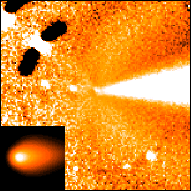
July 5, 2000
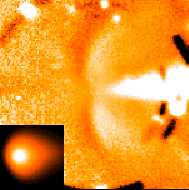
July 6, 2000
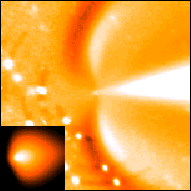
July 7, 2000
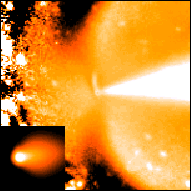
July 8, 2000
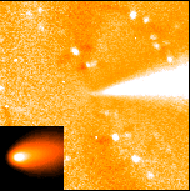
July 9, 2000
Our imaging results consist of measurements obtained with both broadband filters (V and R) and narrowband filters that isolate different moecular species (see the photometry page for more information). Data obtained with the narrowband filters allow us to look at the morphology of the gas species in the coma. So far, our analysis has concentrated on the broadband images, mainly because the give the highest signal-to-noise.
We have images, obtained from McDonald Observatory and Lowell
Observatory, on 28 nights between November 2, 1999 and July 9 2000.
Typically, the observations consist of approximately monthly coverage
(when the comet was not too close to the sun), however, in January and
July we have extensive coverage.
From the time it was discovered through March 2000, when it went into solar conjunction, LINEAR had a typical round or teardrop shape to its coma. There were no obvious features or significant changes in the coma or tail.
After LINEAR come out of solar conjunction in May, however, it had
changed markedly. It frequently displayed unusual morphologies in its
inner coma and experienced a number of outbursts. Various observers
recorded large outbursts on June 2, June 16, July 5 and July 18, with
a number of smaller outbursts in between.
From July 5-9, 2000, we obtained images of comet LINEAR. On July 5, an outburst occurred, in which the comet brightened by at least 1.5 magnitudes and was accompanied by very dramatic changes in the appearance of the coma. Furthermore, the Hubble Space Telescope observed a fragment that had broken off the nucleus and was drifting down the tail.
 July 5, 2000 |
 July 6, 2000 |
 July 7, 2000 |
 July 8, 2000 |
 July 9, 2000 |
This sequence of images shows the evolution of the coma after the outburst on July 5, 2000. The images were obtained with an R-band filter and have been processed to remove the bright central peak and to enhance the low contrast features. The nucleus is at the center of each image, and the sun is to the left. The bright triangle extending to the right is the plasma tail, over-enhanced by the processing. The inset images show, at the same scale, the shape of the inner third of the larger frame, with no processing.
The inset images show the coma getting brighter on July 5 and 6, and then fading again over the next few days. The coma also broadens out perpendicular to the sun-comet line, producing a rounder shape than before. After the comet fades again, the coma is more elongated than it was before the outburst.
The larger images show the dramatic changes in the coma morphology. On July 5, there is little structure in the coma other than the plasma tail. On July 6, "wings" start to form perpendicular to the comet-sun line, reaching their brightest point on July 7 before they start to fade again.
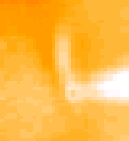 |
On July 8, a 5000-km (3000 mile) long jet was seen pointing upward from the nucleus. A blow-up of the region showing the jet is shown here. |
The wings and jet are formed by dust being emitted from an active region or vent on the surface of the comet. As the dust moves outward, solar radiation pressure pushes it away from the sun, making the wings appear to curve.
It is unlikely that the wings are formed by two separate vents,
because they appear so much alike from night to night and they appear
concurrently with outbursts (the same features were seen after at
least two other outbursts). So the most likely explanation is that
there is only one active region, but the nucleus is spinning, causing
the vent to point in different directions. When the vent is near the
plane of the sky, the emission forms the wings that we see. On July
8, emission from the vent is actually seen as the 5000-km (3000 mile)
long jet.
The previous interpretation of the coma morphology allows us constrain some of the properties of the nucleus' rotation state:
Go to the Imaging Results from After Breakup.
Return to the LINEAR 1999 S4 Home Page.